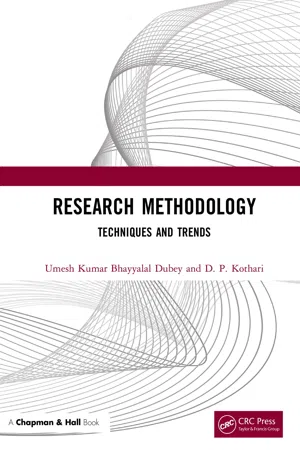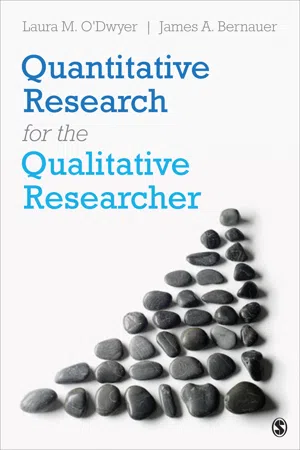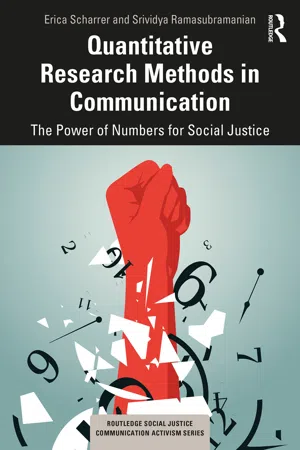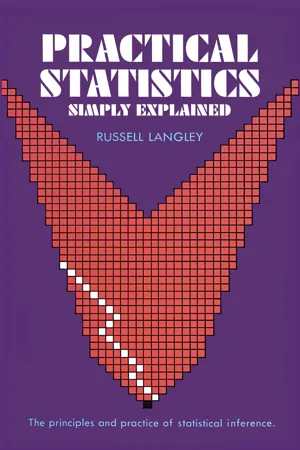Psychology
Random Sampling
Random sampling is a method of selecting a sample from a larger population in a way that each member of the population has an equal chance of being chosen. This technique is used to ensure that the sample is representative of the population, allowing for generalization of findings. In psychology, random sampling is crucial for obtaining unbiased and reliable data for research.
Written by Perlego with AI-assistance
Related key terms
10 Key excerpts on "Random Sampling"
- eBook - ePub
Dissertation Research Methods
A Step-by-Step Guide to Writing Up Your Research in the Social Sciences
- Philip Adu, D. Anthony Miles(Authors)
- 2023(Publication Date)
- Routledge(Publisher)
Hancock & Mueller, 2010 ).The practice of probability sampling is based on a sampling technique in which each unit in a population has a specifiable chance of being selected. The rationale behind using probability sampling is to generate a sample that is representative of the population from which it was drawn. With probability and Random Sampling, it does not guarantee that every random sample perfectly represents the population. Instead, what it means is that the sample will be close to the population most of the time, and that one can calculate the probability of a particular sample being accurate (Alvi, 2016 ; Tong, 2006 ; Gelo et al., 2008 ; Singh & Masuku, 2013 ; Sarstedt et al., 2017 ).Quantitative Sampling Designs for Research
Simple Random Sampling
Simple Random Sampling is a method in which any two groups of equal size in the population are equally likely to be selected. Mathematically, simple Random Sampling selects n units out of a population of size N. So that every sample of size n has an equal chance of being drawn in this case, we have a full list of sample units or participants (sample basis), and we randomly select individuals using a table of random numbers. This sampling technique provides an unbiased and better estimate of the parameters if the population is homogeneous (Brown, 1947 ; Sudman, 1976 ; Lomax, 2001 ; Acharya et al., 2013 ; Singh & Masuku, 2013 ; Taherdoost, 2016 ; Fricker, 2020 ; Rai & Thapa, 2015 ).In situations where the population is heterogeneous regarding the measures of interest, simple Random Sampling easily leads to estimates with unacceptably high variance, especially when the sample size is restricted. Interestingly, in survey research, much time and effort are spent in following a method of simple Random Sampling until an individual is actually identified and enrolled in the sample. However, this is called cluster sampling. Given that there is usually a tendency for individuals found within a cluster to share characteristics, however, the use of cluster sampling can be expected to decrease the precision of the sample result (Lasswell, 1949 ; Henderson & Sundaresan, 1982 ; Scheaffer et al., 2006 ; Sarstedt et al., 2017 - eBook - ePub
Research Methodology
Techniques and Trends
- Umesh Kumar B Dubey, D P Kothari(Authors)
- 2022(Publication Date)
- Chapman and Hall/CRC(Publisher)
- In probability sampling methods, there is no chance of arbitrary or biased selection and therefore the laws of probability holds true. Therefore, it permits us to measure the sampling error, which is the difference between the population value and the sample value.
Under probability sampling methods there are a number of different sampling procedures. Some of these methods are Simple Random Sampling, Systematic Sampling, Stratified Sampling, Cluster Sampling, Area Sampling, and Multistage Sampling.Probability sampling method helps in estimating sampling errors and evaluating sample results in terms of their precision, accuracy, efficiency, etc.6.3.1.1 Simple Random Sampling
Simple Random Sampling is a sampling process in which each element in the target population has an equal chance or probability of inclusion in the sample. Under this sampling design each member of the population has known and equal probability of being included in the sample.A simple random sample is one in which each item in the total population has an equal chance of being included in the sample. In addition, the selection of one item for inclusion in the sample should in no way influence the selection of another item. Simple Random Sampling should be used with a homogeneous population. Homogeneous population comprises items that possess the same attributes that the researcher is interested in. The characteristics of homogeneity may include such as age, sex, income, social or religious or political affiliation, geographical region, etc. The best way to choose a simple random sample is to use a random number table. A Random Sampling method should meet the criteria such as every member of the population must have an equal chance of inclusion in the sample and the selection of one member is not affected by the selection of previous members.Random NumbersThe random numbers are a collection of digits generated through a probabilistic mechanism.The following are the properties of random numbers:- The probability that each digit 0, 1, 2, 3, 4, 5, 6, 7, 8 or 9 will appear at any place is the same. That is 1/10.
- Laura M. O′Dwyer, James A. Bernauer(Authors)
- 2013(Publication Date)
- SAGE Publications, Inc(Publisher)
external validity. Whether a researcher is conducting an experiment to examine the effect of an intervention or is collecting survey data to simply describe some phenomenon, the philosophical assumptions of the quantitative tradition require that he or she considers whether the study's findings can be generalized beyond the individuals or groups involved in the study and beyond the context in which the research occurred (Cook & Campbell, 1976, 1979). In the case of experimental research where the researcher aims to establish a causal link between the effect of a treatment and some measured attribute, Cook and Campbell (1979) define external validity as the “approximate validity with which we can infer that the presumed causal relationship can be generalized to and across alternate measures of the cause and effect and across different types of persons, settings, and times” (p. 37). In this chapter, we describe the process of sampling and the concept of external validity.Sampling: Choosing Participants for Research Studies
Sampling is the process of selecting a sample from a population that will be used in the research process, and the subset of units that is the result of the sampling process is called the sample. Several different procedures can be used to select a sample, and sampling is the umbrella term for these procedures. In many social science research studies, the sample comprises individuals or groups of individuals. Sampling procedures are central to conducting quantitative research as they dictate the degree to which generalizations can be made beyond the current study. In fact, the use of these procedures is often what differentiates it from research in the qualitative tradition.In the quantitative tradition, the capacity for generalization is closely related to how the population is defined; who is selected from the population to be in the study; and how they are selected. This is not to say that external validity is only a function of the sampling plan; there are several additional facets to external validity; and these will be discussed later in this chapter. However, before proceeding to discuss sampling issues, we will define some important terms.A population includes all individuals or groups that possess the characteristic that the researcher aims to investigate. Beyond this broad definition of the term is a more nuanced delineation between a target population and an accessible population. The target population is the ideal population that the researcher wishes to generalize to; however, in cases where this population is not available to researchers, they must select their sample from the accessible population- eBook - ePub
Statistics: An Introduction: Teach Yourself
The Easy Way to Learn Stats
- Alan Graham(Author)
- 2017(Publication Date)
- Teach Yourself(Publisher)
N, is known as a ‘census’.Random SamplingThe tale of Keith Parchment illustrates two very important features of sampling. First, if a sample is too small it may not provide a very reliable or representative cross-section of the population as a whole and indeed may give a wrong impression of it. Second, there is the other side to this coin, namely that large samples, although they may be highly representative and accurately reflect the population, are usually also very expensive and time-consuming to carry out. In practical terms, therefore, sampling is always a compromise between accuracy on the one hand and cost on the other.A random sample is one in which every item in the population is equally likely to be chosen.There are several techniques for choosing a representative sample, of which probably the best known is Random Sampling. Its basic definition is as follows.With Random Sampling, there also needs to be some sort of random-generating process used to select each item. Suppose, for example, we wished to select a sample of size 50 (sample size, n = 50) from a population consisting of a sampling frame of size 1000 (i.e. N = 1000). The usual approach would be to allocate a number to each item in the sampling frame (from 1 to 1000 or perhaps from 0 to 999) and then find some way of randomly generating 50 numbers from within this range. The population items which had been allocated these numbers then become the 50 items which form our sample.There are two common methods of Random Sampling – sampling with replacement and without replacement. Replacement means simply putting an item back into the sampling frame after it has been selected. Although replacement is sometimes thought of as being a more correct form of Random Sampling, in most practical sampling situations items are not replaced after they have been selected. - eBook - ePub
- Alan Graham(Author)
- 2010(Publication Date)
- Teach Yourself(Publisher)
N, is known as a ‘census’.Random SamplingThe tale of Keith Parchment illustrates two very important features of sampling. First, if a sample is too small, it may not provide a very reliable or representative cross-section of the population as a whole and indeed may give a wrong impression of it. Second, there is the other side to this coin, namely that large samples, although they may be highly representative and accurately reflect the population, are usually also very expensive and time-consuming to carry out. In practical terms, therefore, sampling is always a compromise between accuracy, on the one hand, and cost on the other.A random sample is one in which every item in the population is equally likely to be chosen.There are several techniques for choosing a representative sample, of which probably the best known is Random Sampling. Its basic definition is as follows.With Random Sampling, there also needs to be some sort of random-generating process used to select each item. Suppose, for example, we wished to select a sample of size 50 (sample size, n = 50) from a population consisting of a sampling frame of size 1000 (i.e. N = 1000). The usual approach would be to allocate a number to each item in the sampling frame (from 1 to 1000 or perhaps from 0 to 999) and then find some way of randomly generating 50 numbers from within this range. The population items which had been allocated these numbers then become the 50 items which form our sample.There are two common methods of Random Sampling – sampling with replacement and without replacement. Replacement means simply putting an item back into the sampling frame after it has been selected. Although replacement is sometimes thought of as being a more correct form of Random Sampling, in most practical sampling situations items are not replaced after they have been selected. - eBook - ePub
Social Research Methodology
Qualitative and Quantitative Designs
- Avdhesh Jha(Author)
- 2023(Publication Date)
- Routledge India(Publisher)
The demerits of randomization depict it to be expensive with respect to time and manpower. Randomization does not fully ensure the representativeness of the population, and if it is not done rigorously, it involves subjectivity. Randomization cannot be used effectively if the authorities do not permit selecting subjects randomly from a class or an institution. It is difficult to list all the elements of the population and also to represent the whole population. The validity of the inferences depends directly upon the sample size.Let Us Recall Types of sampling: Sampling can be categorized into probability and non-probability sampling.Probability sampling: The sampling that renders each element of a finite population a known, non-zero chance of selection as a sample element is referred to as probability sampling. The probability sampling assures representativeness of the sample and enables generalization of the results of sample data to the population from which they were drawn. Probability sampling includes simple Random Sampling, stratified sampling, systematic sampling, cluster sampling and multistage sampling.Non-probability sampling: Based on the ease, convenience, purpose or judgement of the researcher in relation to the sample, non-probability sampling refers to the sampling method that fails to offer every element of the population with a known probability of being included as a sample. The non-probability sampling includes convenience sampling, judgement sampling, quota sampling, double sampling, snowball sampling and expert sampling.Randomization: Randomization refers to a fixed and methodical selection procedure of probability sampling in which each element of the population has an equal and independent chance of selection as a sample element. It includes the lottery method, tippets table or table of random numbers, round table method or Roulette method, tossing a coin and computer arranged array. - eBook - ePub
Quantitative Research Methods in Communication
The Power of Numbers for Social Justice
- Erica Scharrer, Srividya Ramasubramanian(Authors)
- 2021(Publication Date)
- Routledge(Publisher)
Research methods guru Earl Babbie (2010) reminds us that, “In connection with sampling, bias simply means that those selected are not typical or representative of the larger populations that they have been chosen from. This kind of bias does not have to be intentional. In fact, it is virtually inevitable when you pick people by the seat of your pants” (p. 197). Biases can seep in consciously or unconsciously. In either case, the result is a sample that does not reflect the population, which threatens generalizability of findings.The researcher drawing a random sample has a number of options to use. One common method of probability sampling is the simple random sample (Figure 4.4 ). In order to draw a simple random sample, the researcher must have an exhaustive list of every unit in the population, also known as the sampling frame. The units in that list are assigned numbers (if they do not already have them), and a random number generator selects numbers within that range to constitute the sample. For instance, to obtain a simple random sample of students on a college campus, a list of all currently enrolled students could be obtained from the registrar and then numbered. If there are, for instance, 10,000 student names, the researcher could program a random number generator to provide 100 random selections between 1 and 10,000. The students assigned to each of those 100 numbers would then comprise a simple random sample of 100 students that could be used in research to represent the larger student body.Wondering how to access a random number generator? It used to be routine practice to print a table of random numbers in quantitative research methods books or statistics textbooks for many decades, and some of them still contain such a feature. Yet, the modern researcher can also use one of many free online programs to generate random numbers within defined ranges, as well. As of this writing, random number generators can be found online at https://andrew.hedges.name/experiments/random/ ; randomnumbergenerator.com ; or randomizer.org .Figure 4.4 Simple Random SamplingSource: Stephen WarrenA variation on the simple random sample method is the stratified random sample. This technique is useful when the population can be divided into subgroups (“strata - Michael R. Chernick(Author)
- 2011(Publication Date)
- Wiley(Publisher)
CHAPTER 2 Sampling from PopulationsOne of the key aspects of statistics and statistical inference is to draw conclusions about a population based on a sample. Our ability to make good inferences requires an intelligent design and must include some form of Random Sampling. Random Sampling is needed so that the sample can be analyzed based on the probability mechanism that generates the sample. This way, estimates based on the sample data can be obtained, and inference drawn based on the probability distribution associated with the sample.To illustrate, suppose we select five students at random from a math class of 40 students. We will formally define Random Sampling later. If we give a math test to these students based on the material they have studied in the class, and we average the five scores, we will have a prediction of what the class average for that test will be. This prediction will be unbiased (meaning that if we repeatedly took samples of and averaged them, the average of the averages will approach the class average).In practice, we do not repeat the process, but we do draw inference based on the properties of the sampling procedure. On the other hand, suppose we selected the five students to be the ones with the highest class average thus far in the class. In that case, we would not have a random sample, and the average of this group could be expected to be higher than the class average. The amount that it is higher is the bias of the prediction. Bias is something we want to avoid because usually we cannot adjust our estimate to get a good prediction.In addition to bias (which can be avoided by randomization), an estimate or prediction will have a variance. The variance is a measure of the variability in estimates that would be obtained by repeating the sampling process. While bias cannot be controlled by the sample size, the variance can. The larger the sample size is, the smaller is the variance of the estimate, or in the example, above the prediction of the class average.- eBook - ePub
- Dr. Russell A. Langley(Author)
- 2013(Publication Date)
- Dover Publications(Publisher)
The use of samples has proved invaluable in literally thousands of different fields. But they can also lead to mistakes. So the question arises: When can a sample be trusted?It all depends on the way the sample has been selected. A sample can be trusted (within limits that can be calculated) provided that every single individual in the parent group has an equal chance of being chosen in the sample. A sample which has been chosen in this way is called a random sample.Now, the word ‘random’ has a specific meaning in statistical work. It does not simply mean haphazard or aimless. It does not even necessarily imply that such a sample is a typical cross-section of its parent group. It refers only to a particular way of selecting individuals from a parent group, in which care is taken to see that every individual has the same chance of being included in the sample group. The Laws of Chance will therefore only apply to random samples.In practice, to get a random sample is not easy. It’s not good enough to get an expert to choose what he considers to be a representative selection; after all, different experts may vary as to which individuals are ‘representative’. If you are after a random sample of people, it’s not good enough to stand on a street corner and select every fifth person who passes; this would exclude habitual motorists from your sample. Call on 50 homes in different areas, and you may end up with only housewives’ opinions, their husbands being away at work. Pick a set of names with a pin from a telephone directory, and you automatically exclude those people who don’t have a telephone. Think up a set of unrelated numbers to select your sample, and you’ll find that the mind unconsciously tends to form patterns which destroy the randomness. And after the fiasco of the troop mobilization incident (p. 37 ), a statistician won’t even trust names or numbers picked blindly from a hat.There is only one way to be absolutely sure of getting a true random sample. It is to assign a number to each individual in the parent group, and then select the requisite number of individuals to make up the sample group by using a Table of Random Numbers. A selection of random numbers is given opposite. These numbers have been found by a kind of electronic roulette wheel and have been checked in many different ways to ensure that they are as random as possible. They are chaotic, in that there is no rule connecting any digit with its neighbours, and yet there is a kind of overall regularity, in that each digit tends to occur with equal frequency when the Table is viewed as a whole. - eBook - ePub
Evaluating Research in Academic Journals
A Practical Guide to Realistic Evaluation
- Maria Tcherni-Buzzeo, Fred Pyrczak(Authors)
- 2018(Publication Date)
- Routledge(Publisher)
Because many researchers do not explicitly state whether they are attempting to generalize, consumers of research often need to make a judgment on this matter in order to decide whether to apply the evaluation questions in this chapter to the empirical research article being evaluated. To make this decision, consider these questions:- Does the researcher imply that the results apply to some larger population?
- Does the researcher discuss the implications of his or her research for a larger group of individuals than the one directly studied?
If the answers are clearly “yes”, apply the evaluation questions in this chapter to the article being evaluated. Note that the evaluation of samples when researchers are clearly not attempting to generalize to populations (a much less likely scenario for social science research) is considered in the next chapter.___ 1. Was Random Sampling Used?
Comment : Using random, or probability, sampling (like drawing names out of a hat3 ) yields an unbiased sample (i.e., a sample that does not systematically favor any particular type of individual or group in the selection process). If a sample is unbiased and reasonably large, researchers are likely to make sound generalizations. (Sample size will be discussed later in this chapter.)The desirability of using Random Sampling as the basis for making generalizations is so widely recognized among researchers that they are almost certain to mention its use if it was employed in selecting their sample. Examples 6.1.1 and 6.1.2 show two instances of how this has recently been expressed in published research.Example 6.1.1 4
DESCRIPTION OF THE USE OF Random Sampling (A NATIONALLY REPRESENTATIVE SAMPLE OF ADOLESCENTS IN THE UNITED STATES)Data for this study came from the National Longitudinal Study of Adolescent Health (Add Health; Harris, 2009). The Add Health is a longitudinal and nationally representative sample of adolescents enrolled in grades 7 through 12 for the 1994–1995 academic year. The general focus of the Add Health study was to assess the health and development of American adolescents. In order to do so, a sample of high schools was first selected by employing stratified Random Sampling techniques. During this step, 132 schools were selected for participation and all students attending these schools were asked to complete a self-report questionnaire (N ~ 90,000).
Index pages curate the most relevant extracts from our library of academic textbooks. They’ve been created using an in-house natural language model (NLM), each adding context and meaning to key research topics.









